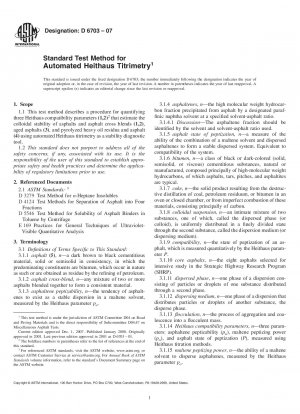ASTM D6703-07
Standard Test Method for Automated Heithaus Titrimetry
- Standard No.
- ASTM D6703-07
- Release Date
- 2007
- Published By
- American Society for Testing and Materials (ASTM)
- Status
- Replace By
- ASTM D6703-13
- Latest
- ASTM D6703-19
- Scope
This test method is intended primarily as a laboratory diagnostic tool for estimating the colloidal stability of asphalt, asphalt cross blends, aged asphalt, pyrolyzed asphalt, and heavy oil residuum. Historically, asphalt and heavy oil residua have been modeled as colloidal suspensions (8,9) in which a polar, associated asphaltene moiety (the dispersed phase) is suspended in a maltene solvent moiety (the dispersing medium) (refer to test methods D 3279
, D 4124 , and D 5546 for further definition of asphalt fraction materials). The extent to which these two moieties remain in a given state of peptization is a measure of the compatibility of the suspension. Compatibility influences important physical properties of these materials, including rheological properties, for example, phase angle and viscosity (10,11). Compatibility also influences coke formation in refining processes (4). This test method and other similar test methods (7, 12-15), along with the classical Heithaus test (1,2), measures the overall compatibility of a colloidal system by determining a designated parameter referred to as the state of peptization, P. The value of P commonly varies between 2.5 and 10 for unmodified or neat asphalts. Materials calculated to have low values of P are designated as incompatible, where as materials calculated to have high P values are designated as compatible. Values of P may be calculated as a function of two other designated parameters that relate to the peptizability of the asphaltene moiety (the asphaltene peptizability parameter, pa) and the solvent power of the maltene moiety (the maltene peptizing power parameter, po). Values of pa and po are calculated as functions of the quantities Cmin and FRmax, the values of which are obtained from three experimental variables, the weight of residuum or asphalt (Wa), the volume of solvent (VS), and the volume of titrant added up to the flocculation point (VT). 1.1 This test method describes a procedure for quantifying three Heithaus compatibility parameters (1,2) that estimate the colloidal stability of asphalts and asphalt cross blends (1,2), aged asphalts (3), and pyrolyzed heavy oil residua and asphalt (4) using automated Heithaus titrimetry as a stability diagnostic tool.
1.2 This standard does not purport to address all of the safety concerns, if any, associated with its use. It is the responsibility of the user of this standard to establish appropriate safety and health practices and determine the applicability of regulatory limitations prior to use.
ASTM D6703-07 Referenced Document
- ASTM D3279 Standard Test Method for n-Heptane Insolubles
- ASTM D4124 Standard Test Methods for Separation of Asphalt into Four Fractions
- ASTM D5546 Standard Test Method for Solubility of Asphalt Binders in Toluene by Centrifuge
- ASTM E169 Standard Practices for General Techniques of Ultraviolet-Visible Quantitative Analysis
ASTM D6703-07 history
- 2019 ASTM D6703-19 Standard Test Method for Automated Heithaus Titrimetry
- 2014 ASTM D6703-14 Standard Test Method for Automated Heithaus Titrimetry
- 2013 ASTM D6703-13 Standard Test Method for Automated Heithaus Titrimetry
- 2007 ASTM D6703-07 Standard Test Method for Automated Heithaus Titrimetry
- 2001 ASTM D6703-01 Standard Test Method for Automated Heithaus Titrimetry
